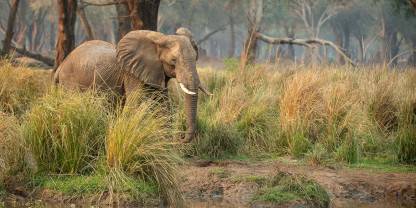Chizarira National Park is one of Zimbabwe’s largest national parks and home to four of the Big Five (rhino is missing). Despite this, it is very remote and little visited, and animal densities are low as a result of ongoing poaching. Chizarira’s main attraction is undoubtedly its enormous wilderness appeal. It is well suited to the adventurous traveler, with guided a big part of the experience.

-
Best Time To Go
- July to October
-
High Season
- June to August (Chizarira never gets busy)
-
Size
- 1,920km² / 741mi²
-
Altitude
-
704-1,240m /2,310-4,068ft
Pros & Cons
- Good general wildlife and four of the Big Five are present
- are excellent
- Beautiful, rugged scenery
- Remote and rarely visited
- There are no accommodations in or near the park, only camping
- Poaching is a problem
- Both access roads and game-drive tracks are difficult year-round
Wildlife
Elephant and buffalo are regularly seen. The terrain is excellent for leopard, and lion and spotted hyena are also present, but none of these predators is seen with any regularity. There are good populations of antelope including klipspringer, impala and greater kudu. Roan and tsessebe, seldom seen in other parks, are also present.
More about Chizarira’s wildlifeScenery
Chizarira’s rugged and dramatic terrain is dominated by the formidable Zambezi Escarpment, as alluded to in the park name, which derives from a local Tonga word meaning ‘Great Barrier’. The park encompasses seven ecological zones, from Lowveld valley savannah to Highveld broadleaf woodland. Lush pockets of vegetation, fed by natural springs, are found in the valleys between the mountain ridges.
Activities
The range of activities on offer in Chizarira is somewhat limited. There are very few roads and those that do exist tend to be rough going and unsuited to recreational . The main reason people visit Chizarira is to go wilderness camping or on a , which is best arranged in advance with an experienced professional guide.
Weather & Climate
Chizarira’s mild climate is subject to two distinctive periods. The Dry season (April to October) is marked by generally warm days and cold nights. Everything changes with the coming of the very warm Wet season (November to March), especially in October when the park’s lower altitudes bake in temperatures of up to 40°C/104°F.
More about the weather and climateBest Time To Visit
From July to October, during the middle and end of the Dry season, is the best time to spot animals at Chizarira’s and rivers. Sunny, clear skies and no mosquitoes are other advantages of visiting at this time of year. The greenery does flourish when the rains come, but this tends to be outweighed by unreliable roads.
More about the best time to visit
